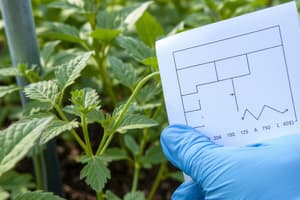Podcast
Questions and Answers
What is the primary purpose of plant quarantine legislation?
What is the primary purpose of plant quarantine legislation?
To regulate the movement of plant materials and prevent the introduction and establishment of exotic pests.
How are quarantine pests defined according to international standards?
How are quarantine pests defined according to international standards?
Quarantine pests are pests of potential economic importance that are present but not widely distributed and are under official control.
Explain the economic impact of pests on agriculture.
Explain the economic impact of pests on agriculture.
Pests can lead to reduced crop yields, lower quality of produce, and increased management costs, impacting food security and livelihoods.
Describe the main components involved in the pest risk assessment process.
Describe the main components involved in the pest risk assessment process.
What are non-quarantine pests, and why are they important?
What are non-quarantine pests, and why are they important?
Give an example of a significant pest and its impact on international agriculture.
Give an example of a significant pest and its impact on international agriculture.
How do pest pathways contribute to the spread of agricultural pests?
How do pest pathways contribute to the spread of agricultural pests?
What roles do plant protection methods like exclusion and eradication play in pest management?
What roles do plant protection methods like exclusion and eradication play in pest management?
What are the main objectives of Pest Risk Assessment (PRA) conducted by Pakistan in the context of managing pest threats?
What are the main objectives of Pest Risk Assessment (PRA) conducted by Pakistan in the context of managing pest threats?
Define a quarantine pest and explain why it is significant for agricultural management.
Define a quarantine pest and explain why it is significant for agricultural management.
Why is it important for countries like Pakistan to engage in technical exchanges regarding pest management?
Why is it important for countries like Pakistan to engage in technical exchanges regarding pest management?
List two conditions under which a pest would not be considered a threat according to the Canadian guidelines.
List two conditions under which a pest would not be considered a threat according to the Canadian guidelines.
What is the significance of distinguishing between quarantine and non-quarantine pests in an agricultural framework?
What is the significance of distinguishing between quarantine and non-quarantine pests in an agricultural framework?
Explain the economic impact that pests can have on agriculture, using examples from the content provided.
Explain the economic impact that pests can have on agriculture, using examples from the content provided.
What is the primary focus of ISPM 15?
What is the primary focus of ISPM 15?
What differentiates a quarantine pest from a regulated non-quarantine pest?
What differentiates a quarantine pest from a regulated non-quarantine pest?
In the context of pest risk analysis (PRA), what is the significance of Stage I?
In the context of pest risk analysis (PRA), what is the significance of Stage I?
How does ISPM 21 contribute to pest management?
How does ISPM 21 contribute to pest management?
What are the three stages of the pest risk management process as defined in the PRA?
What are the three stages of the pest risk management process as defined in the PRA?
Why is it important for pest risk assessments to be technically robust?
Why is it important for pest risk assessments to be technically robust?
What types of organisms may be classified as pests according to the provided definitions?
What types of organisms may be classified as pests according to the provided definitions?
What role does economic impact play in pest risk assessments?
What role does economic impact play in pest risk assessments?
What are the main components of a pest risk analysis process?
What are the main components of a pest risk analysis process?
How do ISPM guidelines contribute to international trade?
How do ISPM guidelines contribute to international trade?
Flashcards are hidden until you start studying
Study Notes
Plant Protection and Quarantine
- Plant protection aims to enhance crop productivity and improve produce quality.
- It includes control measures such as exclusion, management, and eradication of pests.
- Legislation regulates the movement of plant materials to prevent the introduction and establishment of exotic pests.
Definition of Pests
- Pests encompass any harmful species, strain, or biotype affecting plants, including insects, mites, nematodes, fungi, bacteria, viruses, and weeds.
- Quarantine pests are economically significant and present but not widespread, requiring official control.
International Spread of Pests
- Documented cases include diseases like late blight in potatoes from Central America to Europe and various grape mildew infections between the USA and France.
- Notable pests such as the boll weevil originated from Mexico and impacted cotton production in the USA.
Pathways for Pests
- International Standards for Phytosanitary Measures (ISPM) provide guidelines for pest management and regulations regarding seed, wood packaging, and non-quarantine pests.
- Key guidelines include ISPM 12 for phytosanitary certificates and ISPM 15 regulating wood packaging in trade.
WTO-SPS Regime Implications
- Article 3 focuses on reviewing and harmonizing phytosanitary norms.
- Article 5 emphasizes developing Pest Risk Analysis (PRA) as part of regulatory frameworks.
- Article 6 identifies pest-free areas to manage pest risks effectively.
Pest Risk Analysis (PRA)
- PRA initiates with either commodity-based or pest-based analyses to assess potential risks.
- It is crucial for assessments to be technically sound, justifiable, and achievable.
Stages of PRA
- Stage I: Initiation includes information gathering, policy reviews, and organism determination as pests.
- Stage II: Pest Risk Assessment involves categorization of pests, evaluating the probability of introduction, and assessing economic impacts.
- Stage III: Pest Risk Management entails monitoring, applying phytosanitary measures, and making regulatory decisions.
ISPMs and PRA
- ISPM guidelines provide a structure for various PRA stages, including pest categorization and risk management of quarantine and regulated non-quarantine pests.
Case Study: Import of Canola Seed
- Canadian government requests market access for canola seeds, raising concerns regarding potential pests in Pakistan.
- PRA conducted by Canadian scientists helps identify potential pests.
- Mutual technical exchanges aim to develop mitigating strategies for risks identified.
Conditions Identified by Canada
- Identified pests already present in Pakistan but under unofficial control won’t likely be transmitted via canola seeds.
- Various identified pests (e.g., Curtobacterium flaccumfaciens) pose minimal economic threat, thus supporting importation decisions.
Studying That Suits You
Use AI to generate personalized quizzes and flashcards to suit your learning preferences.




